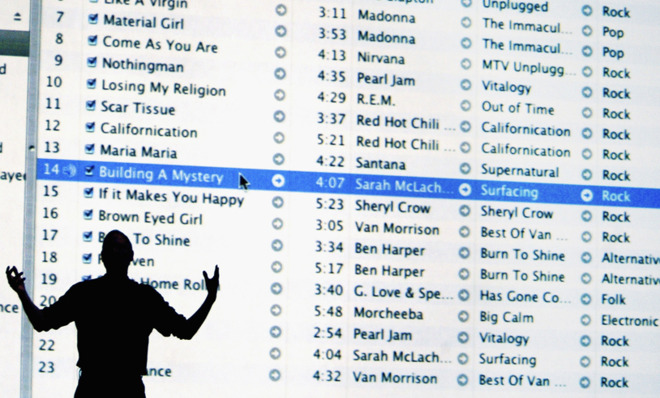How Apple can turn iTunes into an industry-dominating streaming service
It's time for Apple to not only reinvent its music store, but to change the music industry as we know it

When Apple debuted iTunes Match, its cloud music locker feature, in 2011, everyone assumed it was the first step toward iTunes becoming a streaming music service. Three years later, iTunes is still straddling the future and the past, unable to commit to on-demand rental access — all while competitors like Spotify, Rdio, Beats Music, and Deezer push on.
Beats just crossed the 100-day threshold, while Spotify continues to pursue an array of business ventures, lately partnering with Sprint to give subscribers cheaper access to music. Amazon could also emerge as a threat, with reports that the online retail giant is considering incorporating a streaming music service into Prime.
But Apple enjoys advantages that its competitors do not. On the most recent Apple earnings call, it was announced that the iTunes store has some 800 million users — most with credit cards attached. The store was also responsible for $5.2 billion in sales across all media.
The Week
Escape your echo chamber. Get the facts behind the news, plus analysis from multiple perspectives.

Sign up for The Week's Free Newsletters
From our morning news briefing to a weekly Good News Newsletter, get the best of The Week delivered directly to your inbox.
From our morning news briefing to a weekly Good News Newsletter, get the best of The Week delivered directly to your inbox.
This is clearly the time for iTunes to push forward into streaming music, but not as a follower. Apple needs to reinvent the industry in the process.
"When I see iTunes today, I see a static and archaic piece of software that is bloated and old," says GigaOm founder Om Malik. "It needs to feel like it lives on the Internet and not on the desktop. It needs to have a throbbing pulse that comes from a place where music lives, soars, soothes, and entertains."
This is the way streaming music services currently work: Subscribers pay into a pool, which is then divided up among artists. It's a big numbers game in which each played song wins the artist a tiny payment — a fraction of a cent. More subscribers means there's more money to go around.
Apple has the users — roughly 800 million potential customers. What it doesn't have is a business model that moves beyond the existing dynamic between old copyright laws and new digital platforms. In an era when music can be readily copied and disseminated, it's hard to exert your copyright. At the same time, services like Pandora and Spotify have merely covered the old business model in a digital facade, which creates unnecessary middlemen between musicians and profits. All of this makes it difficult for musicians to make money other than through touring.
A free daily email with the biggest news stories of the day – and the best features from TheWeek.com
The rumor back in mid-2007 was that Apple was going to create its own record label and that Jay Z would run it. But Apple doesn't need to start a record label in the traditional sense; it just needs to continue to be the largest content platform in the world.
Mimicking its developers program, Apple could create an artists program and give musicians direct access to sell music. Artists and labels currently go through third-party companies like TuneCore to get their content into iTunes.
Apple already takes 30 percent of music sales, the same as it does for app sales, but allowing artists to set up shop in the world's largest music store could encourage more artists to go independent and collect the full remaining 70 percent, as opposed to sharing it with others.
To be sure, it won't be a cakewalk. Apple would still face competition from the likes of TuneCore.
"Anytime a middle man is removed, there are financial benefits to the artist. The challenge is in weighing the financial benefits against the services, opportunities, and reach that something like a third-party digital distributor can offer," says Ryan O'Neal of the band Sleeping at Last. "Personally, I distribute to iTunes, Spotify, Amazon, Google, and more through TuneCore, which only charges a very small yearly fee ($9.99 to $29.99 per release and receive no percentage of sales) for their distribution services."
However, O'Neal is open to the idea. "If iTunes were to offer direct-to-iTunes benefits like feature opportunities, smaller fees, or other things I would definitely reconsider my options," he says.
Caveats aside, it's clear that more than a decade after Napster burned down the music industry, no one has quite figured out how to rebuild it. No company has wiped the slate clean to reveal a new model that will benefit the broadest number of artists. By starting a streaming service and giving musicians direct access, Apple can create a new music industry with a foundation in digital technology.
Tyler Hayes is a freelance writer living in Southern California. He's just as obsessed with discovering new music as he is with trying new technology.
-
 Trump’s poll collapse: can he stop the slide?
Trump’s poll collapse: can he stop the slide?Talking Point President who promised to ease cost-of-living has found that US economic woes can’t be solved ‘via executive fiat’
-
 Sudoku hard: December 7, 2025
Sudoku hard: December 7, 2025The daily hard sudoku puzzle from The Week
-
 Codeword: December 7, 2025
Codeword: December 7, 2025The daily codeword puzzle from The Week